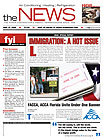
Contractor liability became a question, as illegal immigrants were considered for labor pool replenishment. In a printed statement, Air Conditioning Contractors of America-Texas (ACCA-Texas) said it’s “keenly aware of the effect that laborers have in Texas, both legal and illegal in nature. Many creditable HVACR companies across the state use subcontracting firms to help with installations, and these firms may employ illegal immigrants, either on a full-time or part-time basis. As well, many companies may directly employ illegal immigrants involved in the HVACR industry here in Texas.”
“Personally, I don’t know of a single contractor who employs illegals willingly,” commented Lou Jennings, executive vice president, Metro Mechanical Inc., Phoenix. “There’s just too much liability from many aspects.”
Moving away from the immigration issue, the HVAC industry continued to search for shrinking labor pool replacements. Women emerged as one of the primary targets for recruiting efforts. Speaking at a conference in 2006, William F. Maloney, Ph.D, said that the male participation rate in the HVACR industry in general is dropping, while the female participation rate is increasing.

Report Abusive Comment